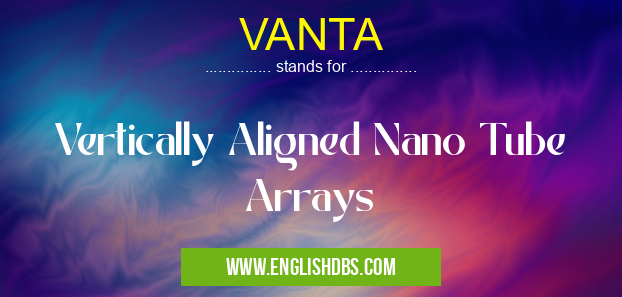What does VANTA mean in UNCLASSIFIED
VANTA stands for Vertically Aligned Nano Tube Arrays. This technology is an advanced material used in various industries, ranging from electronics to medical applications. It has been developed as a means of creating novel materials with unique features and capabilities. VANTA is composed of a network of vertically aligned nano-tubes that are connected together and arranged in a particular pattern. These connections increase the interactions between particles, allowing for enhanced electrical properties, increased thermal conductivity, and improved optical properties.

VANTA meaning in Unclassified in Miscellaneous
VANTA mostly used in an acronym Unclassified in Category Miscellaneous that means Vertically Aligned Nano Tube Arrays
Shorthand: VANTA,
Full Form: Vertically Aligned Nano Tube Arrays
For more information of "Vertically Aligned Nano Tube Arrays", see the section below.
Applications
VANTA technology is widely used across various industries for its unique advantages and efficient performance. The use of VANTAs can offer high-performance electrodes for electronic devices such as battery cells and solar cells, as well as improved heat dissipation for better cooling solutions. Furthermore, VANTAs have been used in medical applications such as drug delivery systems and biomedical implants where they work to reduce implant rejection rates by optimizing particle interactions between materials. In addition, they are also being explored for their potential application in thin-film devices including displays, transistors and light emitting diodes (LEDs).
Essential Questions and Answers on Vertically Aligned Nano Tube Arrays in "MISCELLANEOUS»UNFILED"
What is VANTA?
VANTA stands for Vertically Aligned Nano Tube Arrays. It is a type of nanomaterial structure made out of vertically aligned nanotubes, which are specially arranged and bundled together in an array to create materials with unique electrical, mechanical and optical properties.
How can VANTA be used?
VANTA nanostructures can be applied for a wide range of applications, including energy storage devices, batteries, biomedical devices and sensors, optical devices and displays, electro-optic modulators and more.
What benefits does VANTA offer?
The advantages of using this advanced nanomaterial include improved conductivity, higher surface hardness, greater stability and enhanced environmental protection. Additionally, it has the ability to be produced at low costs.
Is it difficult to produce VANTA?
No. In fact, it is relatively easy to produce compared with other types of nanomaterials due to its straightforward manufacturing process.
What are some current projects using VANTA technology?
Currently there are several research projects that utilize VANTA technology for various applications such as fuel cells, flexible electronics, microelectromechanical systems (MEMS), lithium-ion batteries and more.
What kind of materials is needed for creating VANTA?
The raw material required for making the VANTA structures typically consist of various carbon compounds such as single walled carbon nanotubes or multiwalled carbon nanotubes. Other compounds that may be used include silicon dioxide or zinc oxide nanoparticles.
Is the production process expensive?
Not necessarily; the raw material costs associated with making a VANTA structure depend on quantities used. Generally speaking however, they are quite affordable given the high levels of performance offered.
Can these materials degrade over time?
No; when properly manufactured these materials are highly stable under normal usage conditions and have a long lifespan.
Final Words:
Overall, VANTA is an innovative technology that has seen many applications in multiple industries due to its unique features and superior performance when compared to traditional materials. With its ability to improve electrical properties, thermal conductivity, optical qualities and more, this new technology has greatly revolutionized the way industry works today.
